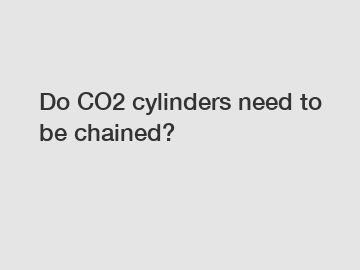Do CO2 cylinders need to be chained?
Carbon dioxide (CO2) cylinders are commonly used in various industries, including food and beverage, welding, and fire extinguisher services. These cylinders contain compressed CO2 gas that is essential for a wide range of applications. However, when it comes to handling and storing these cylinders, safety should always be a top priority. One question that often arises is whether CO2 cylinders need to be chained to prevent them from falling over or causing accidents. In this blog, we will explore the importance of chaining CO2 cylinders and why it is crucial for the safety of both users and bystanders.
First and foremost, it is important to understand the potential hazards associated with CO2 cylinders. These cylinders are pressurized containers that can pose a significant risk if mishandled or improperly stored. If a CO2 cylinder were to fall over or become damaged, it could lead to a sudden release of gas, resulting in serious injuries or damage to property.
Chaining CO2 cylinders is a simple yet effective way to prevent accidents and ensure the safety of everyone in the vicinity. By securing the cylinders in place, you minimize the risk of them tipping over or rolling around, which can cause them to become damaged or potentially hurt someone. Additionally, chaining ensures that the cylinders are stored in an upright position, which is vital for maintaining the integrity of the valve and preventing leaks or other issues.

In many industries where CO2 cylinders are used, such as restaurants, bars, and manufacturing facilities, regulatory bodies require that these cylinders be properly secured at all times. Failure to comply with these regulations can result in fines, penalties, or even legal action. By chaining CO2 cylinders, businesses can demonstrate their commitment to safety and compliance with industry standards.
Furthermore, chaining CO2 cylinders can also help improve efficiency and organization in the workplace. By keeping the cylinders securely in place, employees can easily access them when needed without having to search for misplaced or unsecured cylinders. This can save time and reduce the risk of accidents or injuries that can occur when handling unsecured cylinders.
It is also worth noting that chaining CO2 cylinders is a best practice recommended by industry experts and safety professionals. These professionals understand the potential risks associated with handling compressed gas cylinders and the importance of taking proactive measures to prevent accidents. By following their recommendations and guidelines, businesses can create a safer work environment for their employees and customers.
In addition to chaining CO2 cylinders, it is also important to regularly inspect and maintain them to ensure they are in good working condition. This includes checking for leaks, corrosion, or other damage that could compromise the integrity of the cylinder. If any issues are identified, the cylinder should be taken out of service immediately and replaced or repaired by a qualified professional.
Ultimately, chaining CO2 cylinders is a simple yet crucial step in ensuring the safety of everyone in the vicinity. By securely fastening the cylinders in place, you reduce the risk of accidents, injuries, and property damage that can occur when cylinders are left unsecured. Whether you are a business owner, a safety professional, or simply someone who works with CO2 cylinders, always remember to prioritize safety and follow best practices for handling and storing these essential tools.
In conclusion, chaining CO2 cylinders is a necessary safety measure that should not be overlooked. By securing the cylinders in place, you can prevent accidents, injuries, and property damage that can result from mishandling or improper storage. Remember to always follow industry regulations and guidelines for handling compressed gas cylinders and regularly inspect and maintain them to ensure they are in good working condition. By taking these steps, you can create a safer work environment for everyone.
Want more information on liquid pressure pump application, pressure bench, pneumatic pressure testing equipment? Feel free to contact us.

Comments
0